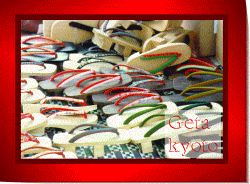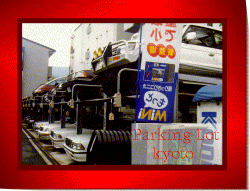
When traveling internationally, Karen and I have tried to present ourselves in the best possible light realizing that we often stood out and were sometimes objects of curiosity. Sometimes we slipped. On one occasion, we were at a train station in Kyoto and were trying to figure out how to purchase the correct ticket from a machine. The information was all in Japanese except for city names which were also in English. We were perplexed by what looked like prices for one-way and round-trip that seemed extremely low priced for Japan. I hit one button without putting money in the machine and Karen chastised me saying that it was the wrong button. Then, acting out my childlike anger, I hit several buttons all at once in retaliation to show her that I couldn't do any harm by punching a button. Just then, to my eternal embarrassment, an older Japanese gentleman made his presence known from behind us and offered his assistance.


Japanese have a love-hate relationship with English. English is taught for several years in school, but rarely can you find anybody who feels comfortable conversing in it. Growing up, I remember seeing many restaurants and retail stores with incomprehensible French names. It was as if a French name gave the establishment a refined, cultural characteristic. In Japan this borrowing of a foreign language to increase the apparent value of something is taken to extreme. It was common for us to see magazines(one was named McSister), books, menus, and stores with English titles or subheadings, but like the "DHL Price Guide" we opened you invariable could not find a word more of English. It was frustrating at times, as a non-Japanese speaking tourist to see these things and be lured into thinking that we would understand more than we could. Comprehension, we did learn, goes both ways. It was not uncommon for us to see English used in new and unfamiliar ways even though I grew up in an English speaking country. A sales slogan for one drink company whose products are sold through some of the numerous vending machines throughout Japan goes: "There's a gallon of deliciousness in every drop. Reach for the taste of good taste, reach for DyDo"; one particular vending machine drink was called "Yogut"(even with my severely restricted knowledge of Japanese I knew this was not a Japanized word for "yogurt" because it's impossible to end a Japanese word with a "t" in this way); in one department store menu we saw "cleam soup", "prain pizza", "a grass of wine", and "tometo sauce"; and finally we saw a leather jacket with lettering on the back that read: "Tipes of Gold Clubs."


One of the unresolved observations we had was that some Japanese women and girls seemed to walk with the front of their feet pointing inward. It can't be genetic because men and boys don't walk in the same way. Nor is it something that seemed to be limited to geisha, maiko, or other traditionally dressed women and girls. [see comment]

There are often two types of toilets at locations in Japan where tourists can be found, the East Asian squat type and the Western chair type. This is nice for Western tourists to Japan because their style toilets are obviously less used than the East Asian variety. We also noticed that it was common for the toilets to have a flush option of "large" and "small" (written in kanji, the characters borrowed from China).

Having read something about Shintoism and Japanese concepts of purity and non-purity, I couldn't help but speculate if the high rate of encounters with people having Down's Syndrome in Kyoto had anything to do with misguided attempts at achieving purity in procreation. (Okay, so I don't have a strong science background!)

After the noisy contingent of American college students had left our small, hundred year old, paper-thin* walled Japanese house turned inn, we went into the communal kitchen to have a peaceful breakfast (*well it wasn't exactly paper-thin because it was constructed from earth and straw, but noised passed through the wood-framed paper doors pretty easily). After a few minutes, the door slid open and one of the owners came in to share the heated room with us. He asked us which state in America we were from. When we told him that we were from the San Francisco area of California and asked him if he had ever been there, he responded "yes." When I asked him what he thought of the town, he replied "no comment." Then he started to relate his dislike of Japanese Americans who he had had some contact with in Los Angeles by saying that he thought they were dirty, lacked good posture and manners, and were generally too laid back, and dishonest. I was surprised by his comments and told him so. The first characterization struck me the hardest though because Japan is an exceptionally clean country, but his inn was extremely dusty as well as being dirty. The dust in our room was causing me to sneeze so much that I decided to pick up some of the dust with a tissue which I ran along strategic areas of the walls and windows. The room looked as if it had not been dusted in its hundred year's of existence. Leaving aside the contradiction between his characterizations and the way he ran his establishment, it seemed to me that our host's comments were influenced by the recent American college students and I interpreted the words as a veiled critique of these particular patron's homeland. This is why it was interesting to me that when I stretched his characterizations to include all Americans, he didn't comment and when I said American society was much looser than Japanese society, making it more difficult for the imposition of social rules he agreed.

There was a note on a board at this same guesthouse that advised people who rented bicycles not to park them "around or in front of other's house. If you leave your bicycle [it] will be removed. [If you put it] in front of other's house, you should get his permission. As land is narrow [sic] in Japan, there's no space to put your bicycle." It was very rare indeed to see a bicycle parked individually and not with a group of bicycles. We saw an official of some sort giving tickets to bicycles parked in the center of an outdoor shopping mall in Osaka that did not appear to be interfering whatsoever with anybody and I saw a man ask for permission of a small shop's owner before he parked his car briefly in front of the shop. While we have been in densely crowded areas of Tokyo on a weekend, Japan does not seem to be suffering from a shortage of land and most people even in large cities appear to live in houses or relatively small buildings. People sometimes seem to have a peculiar sense of land space not just in Japan. I remember visiting Manhattan Island where the land costs have often been compared with Tokyo, but I couldn't figure out why everyone needs to live in such a small area when public transportation to and from the area is so good.


Having a keen interest in debates about the differences of the East and the West and whether or not the East will ever surpass the West economically, it was interesting for me to observe Japanese innovations that we hadn't observed elsewhere (though they may not be confined to Japan). One of these innovations was outdoor parking lots with elevator like stacking facilities that made it possible to stack two layers of parked cars into a small space without building a walled facility. Another, albeit less profound innovation, was lighted license plates. Instead of a light illuminating the plates from the car, the license plate numbers and letters themselves were green lights. These were either new, extremely expensive, or both because we saw very few of them in the cities we visited in Japan.
Traveling by rail both between cities, and by bus and rail within cities is probably more efficient in Japan than anywhere else in the world. It's easier to purchase tickets from their vending machines, which often provide bilingual information, from their attendants, or upgrade a ticket on the train or at the end of a journey than anywhere else. We took busses in Kyoto that had electronic signs displaying the next stop, a sign board displaying several bus routes; audio announcements of stops and connections, often bilingually; a change machine in addition to the fair box, and you could purchase multiple tickets from the driver; and illuminated buttons within reach of every passenger, whether sitting or standing, to request stops. Many of the curbside bus stops in Kyoto have automated black boards with color markers that pop into fill in one of three successive round slots as the approaching bus comes near. In case you take your eye off the board for a few minutes, a chime rings when the last slot is filled in.
There is competition between train services provided by companies such as Japan Rail, Hankyu line, Kintetsu line, Toei line, Tokyu Toyoko line, Odakyu line, Tobu Nikko line, Seibu Shinjuku line, and others. We traveled within Osaka and to a small castle town the same distance again past Kobe and we could have purchased one ticket at the vending machine from our initial journey point in Osaka, or have upgraded a ticket purchased for intra-city travel either on the train or at our destination. You can travel between Kyoto and Osaka in less than forty minutes and for less than ¥400 ($4.00). Between Kyoto and Tokyo you can ride a bullet train, the shinkansen, which will take you the distance, from city center to city center, in about 2.5 hours for about the price of a plane flight which would require you to take additional transportation to the city centers that would probably exceed the flight time itself. On the other hand, you still have an option of drastically reducing the cost of the travel by taking a regular train, American style, on an 8 hour trip.
Taxi drivers open and close passenger doors without leaving their seats or turning around. They have a hand lever next to the steering wheel. They take credit cards which seems a bit strange in a country where cash transactions are so dominant. In ultra expensive Japan, the cost of a taxi ride is one of the more expensive, in Kyoto you have to pay ¥580 just to have the door open and in Tokyo it was ¥70 higher.

